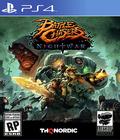Pre-order Battle Chasers: Nightwar
Back in the day, Battle Chasers was Joe Maduriera's independent comic, a fantasy comic that owed a great deal to Japanese RPGs and which took full advantage of "Joe Mad's" fame as the penciler of the best-selling "Uncanny X-Men." It was pretty good for the time, but it shipped nine issues in four years, with the last one ending on a cliffhanger, and then got unceremoniously dropped. Maduriera left comics for a while to become a game developer, and it looked like the Battle Chasers project was dead.
Now, 16 years later and with the help of Kickstarter, Battle Chasers is inexplicably back with Nightwar, a turn-based RPG that we had a chance to check out at E3 2017. Like Maduriera's last project, Darksiders, Nightwar is a surprisingly ambitious game that plays like a grand tour of Maduriera and his team's favorite games in the genre. Some developers will try to downplay or conceal their influences; Nightwar looks like its designers threw every last one of those influences in a blender, added the Battle Chasers cast, and hit "liquefy."
Nightwar is a dungeon crawler at heart, with hub towns, an overworld map to explore with potential random encounters at every stop (and which looks weirdly like the world map from Super Mario Bros. 3, of all things), and a party of seven characters, three of whom can be controlled by the player at any given time.
When you reach the dungeon, each one is procedurally generated and filled with traps, treasure, weird puzzles, and extremely mouthy enemies who taunt you as they beat you. The dungeon's monsters are depicted as roving mobs, much like Chrono Trigger, and contact with one begins a turn-based fight.
The fighting works a lot like you might expect if you've ever played a '90s JRPG; characters attack in orderly turns according to initiative, and the fight is over when one side or the other has been knocked out. One mechanic here, introduced specifically to keep players from falling into the old "hammer the attack button until you win" habit, is that as you fight, you generate resources called Burst and Overcharge, which are then burned on extremely powerful special attacks. Overcharge persists between battles, while Burst meter does not. This was done so there's at least some tactical decision-making in even a throwaway fight. On top of that, in the gameplay sample I was shown, there was a heavy emphasis on your characters' synergy — Garrison inflicts a lot of bleeds, while Calibretto the war golem has a couple of moves that inflict more damage on targets that are bleeding — as well as on inflicting negative statuses. A single stack of poison was a minor annoyance, but four stacks of it dropped a character dead in under two turns.
This was partially down to the game's difficulty system, which was set to heroic at the time. When you enter a dungeon, you can opt to run it on three levels of difficulty, with appropriate rewards given for clearing it on each one, as well as the right challenges. The dungeon I was shown was hard enough that the developers were getting at least one character knocked out in every fight, simply through damage adding up faster than Calibretto could heal it.
Some of those loot rewards include materials for a crafting system, which is a source for some of the best items in the game. Not much was shown about that system except that it was available, but it was brought up that you can use up old gear on crafting in an attempt to upgrade the resulting item's quality level. If you're the sort of player who ends up as a pack rat, you can throw all those random pieces of equipment into the crafting system and get some use out of them.
Your lead character in a dungeon has a special ability with limited charges, which can be used in a variety of ways. Garrison, your standard heavily armored, easily annoyed swordsman archetype, has a short-range dash for avoiding traps or outrunning patrols, while Gilly, an eight-year-old girl with a hero complex and an enormous pair of magical boxing gloves, can inflict an area-of-effect stun that lets you begin a fight with an enemy at an advantage. Red Monika, who you might recognize as the character from all the promotional materials who's wearing almost nothing, has a stealth ability to ambush or evade monsters.
Nightwar has its own plot and adds a brand-new seventh character to the playable party, who by Madureira's admission is kind of a lot like Simon Belmont from Castlevania. It doesn't address the cliffhanger from the end of the original run of Battle Chasers, but a new comic is planned in order to wrap that up.
I wasn't expecting much out of Battle Chasers: Nightwar, honestly. It's a tie-in product to a comic book that's been dead and buried for almost 20 years, and it was a surprise to see it come back. It was a bigger surprise to see it return as a lengthy, colorful love letter to turn-based '90s JRPGs. It's an indie comic made into an indie game in a largely dead genre, which is exactly the kind of laser-narrow niche product that Kickstarter was made to produce. Even if I don't end up liking the final product — and I didn't actually get to play Nightwar — I have to respect the fact that it exists.
More articles about Battle Chasers: Nightwar











 Battle Chasers: Nightwar is a classic JRPG where combat meets action-packed dungeons and stylish storytelling.
Battle Chasers: Nightwar is a classic JRPG where combat meets action-packed dungeons and stylish storytelling.




























